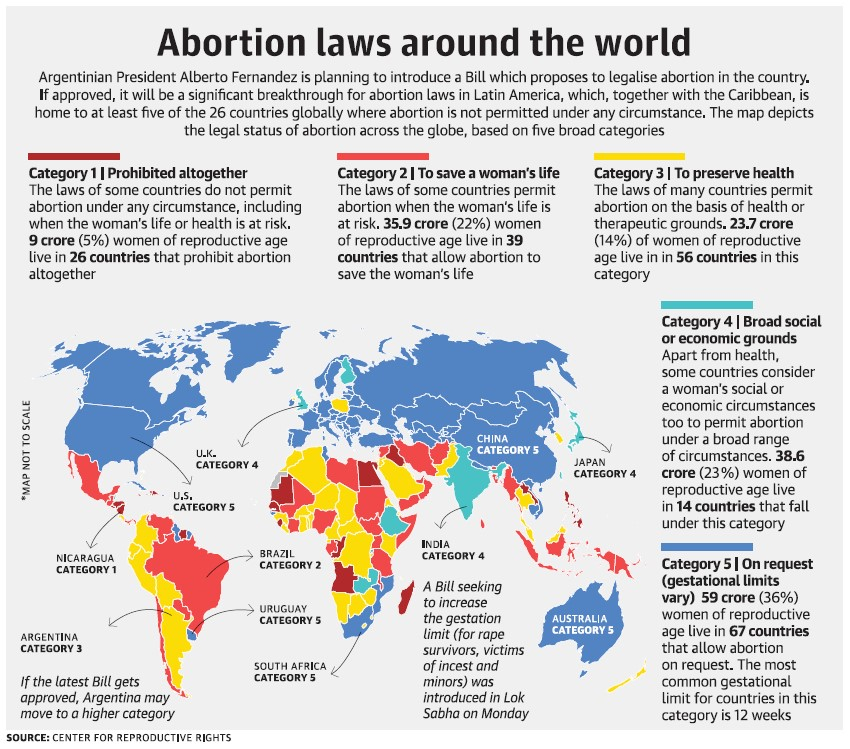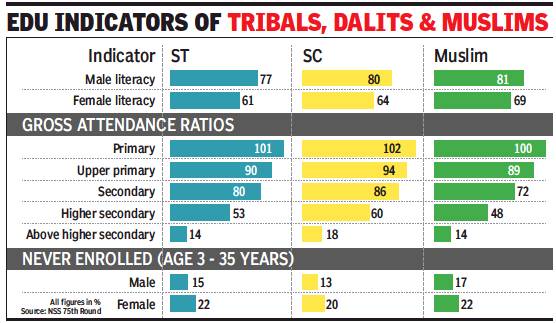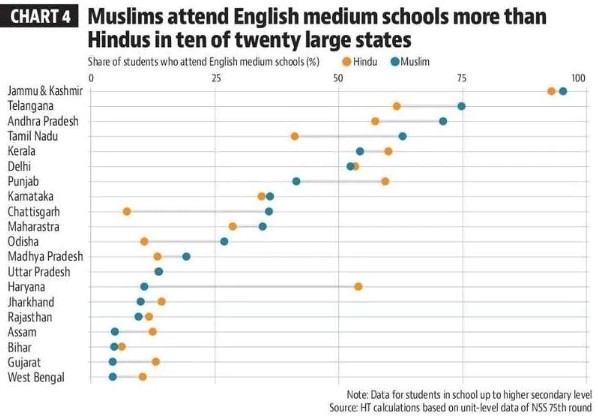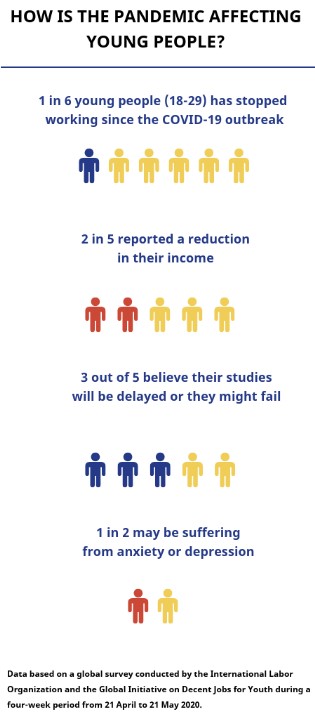Contents
- Over-regulation impeding access to safe abortion
- NSO Report on Literacy
- States asked not to make Independent Vaccine Purchases
- 50% of youth depressed, 17% lost jobs: Survey
OVER-REGULATION IMPEDING ACCESS TO SAFE ABORTION
Focus: GS-II Social Justice
Why in news?
Over-regulation of drugs to curb gender-biased sex selection such as through government programmes like ‘Beti Bachao, Beti Padhao’ has hindered access to safe, legal and cost-effective abortion, according to a survey.
Details
- The Survey found an “overwhelming shortage” of abortion pills or medical abortion drugs.
- The findings show that State-wise regulatory and legal barriers are the key reasons why almost 80% of chemists surveyed refrained from stocking these drugs.
- More than 50 % of chemists also reported that medical abortion drugs were over-regulated as compared to other prescription drugs.
Misunderstood
- The regulatory hurdles are due to a misunderstanding that easy availability of medical abortion drugs will be misused for sex selection.
- There is a lack of knowledge that these drugs are approved for use only up to nine weeks – whereas, an ultrasound can detect a foetus only at around 13-14 weeks.
- The fact that these abortions are allowed under the Medical Termination Act is also neglected.
The law on abortions allows termination of pregnancy in the first nine weeks and in some cases even in the second trimester, such as in sexual assault cases as well as due to foetal anomalies.
- A study on the incidence of abortion and pregnancy in 2015 estimated that more than 80% of abortions annually are medical abortions and nearly 90% of abortions are sought in the first trimester.
The Difference
Abortion pills are different from emergency contraceptive pills. The latter are taken 72 hours after unprotected sex to prevent an unintended pregnancy. Whereas abortion pills or MA drugs are abortafacients which terminate a pregnancy by expelling an embryo or foetus.
Choice reduced
- The lack of availability of MA drugs forces many women to seek a surgical abortion from a facility, reducing her choice.
- It will also reduce access to safe abortion and force them to seek services from unsafe providers as there are only a little over 16 thousand approved abortion facilities in the private sector in the country, whereas, MA drugs can be provided by an obstetrician or a gynaecologist.
- MA drugs are also cost-effective, whereas, the surgical method would set them back by Rs. 2,000-5,000 in Tier 2 and Tier 3 towns and smaller nursing homes or clinics.
Recently in news: Medical Termination of Pregnancy (Amendment) Bill, 2020
- The Lok Sabha passed the Medical Termination of Pregnancy (Amendment) Bill, 2020, which seeks to amend the MTP Act, 1971, to extend the upper limit for permitting abortions from 20 weeks to 24 under “special circumstances.”
- The “special categories of women” include rape survivors, victims of incest, the differently abled and minors, Health Minister said moving the Bill.
Proposals of the Bill:
- The requirement of the opinion of one registered medical practitioner (instead of two or more) for termination of pregnancy up to 20 weeks of gestation (foetal development period from the time of conception until birth).
- Introduce the requirement of the opinion of two registered medical practitioners for termination of pregnancy of 20-24 weeks of gestation.
- Increase the gestation limit for ‘special categories’ of women which includes survivors of rape, victims of incest and other vulnerable women like differently-abled women and minors.
- The “name and other particulars of a woman whose pregnancy has been terminated shall not be revealed”, except to a person authorised in any law that is currently in force.
Background on Abortion in India
- Abortion in India is legal in certain circumstances. It can be performed on various grounds until 20 weeks of pregnancy. In exceptional cases, a court may allow a termination after 24 weeks.
- When a woman gets a pregnancy terminated voluntarily from a service provider, it is called induced abortion. Spontaneous abortion is when the process of abortion starts on its own without any intervention. In common language, this is also known as miscarriage.
- Before 1971, abortion was criminalized under Section 312 of the Indian Penal Code, 1860, describing it as intentionally ‘causing miscarriage’.
- It was in the 1960s, when abortion was legal in 15 countries, that deliberations on a legal framework for induced abortion in India was initiated.
- The alarmingly increased number of abortions taking place put the Ministry of Health and Family Welfare (MoHFW) on alert.
- To address this, the Government of India instated a Committee in 1964 led by Shantilal Shah to come up with suggestions to draft the abortion law for India.
- The recommendations of this Committee were accepted in 1970 and introduced in the Parliament as the Medical Termination of Pregnancy Bill.

-Source: The Hindu
NSO REPORT ON LITERACY
Focus: GS-II Social Justice
Why in news?
A report from the National Statistical Office reveals that Muslims are on various yardsticks of academic marginalisation as bad or even worse than SCs and STs.
Details
- The report shows that among the various social groups, the literacy rate for those aged 7 years or more was the highest for “others”, which is non-SC/ST/OBC population groups, at 91% for men and 81% for women.
- This proportion declines to 84% for OBC men and 69% for OBC women.
- For SCs, the ratio was 80.3% for men and 64% for women and for STs 78% for men and 61% for women.
By religion
- Among religious groups, 88% of Christian men and 82% of women were literate, the highest proportions for both genders. This was followed by Sikhs and Hindus.
- The literacy rate of 80.6% among Muslim men was equivalent to that for dalits and marginally higher than the rate among tribals.
- The literacy rate for Muslim women was higher than dalit or tribal women, but lower than for women of any other religious group.

GAR disproportionate
- The Gross Attendance Ratio (people attending a level of education as a proportion of the population of the corresponding age group) was the lowest for Muslims among social and religious groups at all levels of education except above higher secondary, where it was the between the rates for dalits and tribals.
- At the primary level, the GAR of 100 for Muslims was lower than “others”, SCs, STs, OBCs, Sikhs, Christians, and Hindus.
- At the upper primary level, Muslims were the only community whose GAR was below 90%.
- At the secondary level, the GAR of 71.9% for Muslims was lower than STs
English Medium Education by states
- Data from the recent National Statistical Office (NSO) survey on education, which was conducted in 2017-18 shows in 10 out of 20 large states, the number of Muslims attending English-medium schools, expressed as a proportion of all Muslims attending schools is higher than the corresponding proportion for Hindus.
- Just 6% students were receiving English medium education in Bihar. This number is 63% in Telangana and 95% in Jammu and Kashmir.
- The erstwhile state of Jammu and Kashmir, India’s only Muslim majority state, has the highest prevalence of English medium education in the country.

-Source: Times of India
STATES ASKED NOT TO MAKE INDEPENDENT VACCINE PURCHASES
Focus: GS-II Governance
Why in news?
An expert committee on Vaccine Administration for COVID-19 has advised states not to procure Covid-19 vaccines on their own and said that domestic production capacity and supplies through Gavi, the Vaccine Alliance, would be sufficient for India.
Details
- The Committee said that there will be a unified mechanism to procure vaccines and states have been advised against following independent mechanisms.
- The committee noted that India has a significant domestic production capacity, which could also help to meet the requirements of other countries.
- India is assuming a leadership position and given the capacities that India has, that position should be leveraged for other middle- and lowincome countries, too.
- The government is confident that it can manage with its indigenous production capacity and the mechanism hosted by Gavi, the Vaccine Alliance.
- The Gavi facility will buy vaccines approved by regulatory agencies and/or prequalified by the WHO and will initially provide doses for 20% of the population in 92 lowand middle-income countries.
Concerns being addressed
- The panel also deliberated on the creation of digital infrastructure for inventory management and delivery mechanism for the vaccine, including tracking of the vaccination process with focus on last-mile delivery.
- The committee discussed the broad parameters for selection of Covid-19 vaccine candidates for the country and sought inputs from the standing technical sub-committee of national technical advisory group on immunization
- The expert group discussed the financial resources required to procure the vaccines and funding options.
- The availability of delivery platforms, cold chain and associated infrastructure for the rollout of Covid-19 vaccination was also taken up, as were issues related to safety and surveillance.
- The committee will next meet officials from companies that are leading vaccine development in India.
Global Alliance for Vaccines and Immunizations (GAVI)
- GAVI was created in 2000 as a successor to the Children’s Vaccine Initiative, which had been launched in 1990.
- GAVI is Headquartered in Geneva, Switzerland.
- The GAVI Alliance (formerly the Global Alliance for Vaccines and Immunisation) is a global health partnership of public and private sector organizations dedicated to “immunisation for all”.
- GAVI’s strategy supports its mission to save children’s lives and protect people’s health by increasing access to immunisation in poor countries.
-Source: Economic Times
50% OF YOUTH DEPRESSED, 17% LOST JOBS: SURVEY
Focus: GS-II Social Justice
Why in news?
Half of the world’s youth population is subject to anxiety or depression-causing circumstances and more than a third are uncertain of their future career prospects due to the Covid-19 pandemic, according to a survey by the International Labour Organization (ILO).
Details
- The ILO’s ‘Youth and Covid-19: impacts on jobs, education, rights and mental well-being’ survey found that if urgent action is not taken, youths are at the risk of suffering severe and long-lasting adverse impacts from the pandemic.
- The ILO survey aimed to capture the immediate effects of the pandemic on the lives of youths (aged 18 to 29 years) with regard to employment, education, mental health, rights and social activism.
- The survey found that one in two (i.e., 50 per cent) young people across the world are possibly subject to anxiety or depression, while 17 per cent are probably affected by it.
- Severe disruption to learning and working, compounded by the health crisis, has seen a deterioration in young people’s mental well-being.
- Mental well-being is lowest for young women and younger youths between the ages of 18 and 24 years
- Young people whose education or work was either disrupted or had stopped completely were almost twice as likely to be affected by anxiety or depression as compared to those who continued to be employed or whose education was not affected.
- According to the report, 38 per cent of young people are uncertain of their future career prospects, with the Covid-19 crisis expected to create more obstacles in the labour market and to lengthen the transition from school to work.
- The ILO survey said some youths have already felt the direct impact of the pandemic, with one in six youths having to stop work since the virus outbreak.
- The report said 73 per cent of the young people, who were either studying or combining study and work before the onset of the crisis, experienced school closures though all of them were not able to transition into online and distance learning.
- The coronavirus has left one in eight young people (13 per cent) without any access to courses, teaching or training — a situation particularly acute among the youth in low-income countries and one that serves to underline the sharp digital divide that exists between regions.
- According to the survey, a quarter of the young people have done some kind of volunteer work during the pandemic.

-Source: Business Standard




